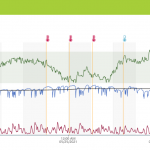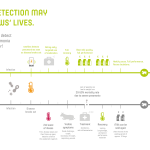Pneumonia is one of the most economically significant diseases in dairy farming because it is a common respiratory disease in dairy cows throughout their lifetime and can have serious consequences - from permanent damage to the lungs associated with subsequent performance losses to the animal's passing away. [1]
The high susceptibility of cows to respiratory diseases is mainly favored by the anatomical structure of the lungs. In general, the low lung capacity in relation to body weight and the late completion of lung development play a role on cattle. [2]
To make matters worse, lung diseases can rarely be traced back to a single cause, but rather a wide variety of factors frequently promote or trigger the disease complex. For example, viral respiratory diseases can weaken the organism and become a precursor for later, bacterial diseases. The germs, which can be found in the organism even in healthy cows, then have easy access to pre-damaged mucous membranes of the respiratory tract and lungs and can cause serious damage. [3]
If the symptoms of cattle flu such as increased temperature, nasal discharge or coughing remain undetected or are not treated until it is too late, cattle flu can turn into chronic pneumonia. In this case, there is a risk of permanent lung damage which can lead to a permanent loss of performance and, in particularly severe cases, even to the death of the animal. [4]
In addition to stress factors such as transport or group mixing, the barn climate, the air quality and the avoidance of drafts in the barn is an essential factor for the health of the herd. What consequences drafts can have for calves and cows, what you can do against drafts in the barn and how the smaXtec Climate Sensor helps you to keep an eye on the barn climate, we highlight in a separate blog post on the topic of drafts in the barn. Click here to read more.
Considerable follow-up costs due to pneumonia
Pneumonia can result in costs of around € 300 per case of illness. Assuming 2 cases of the disease per year on a farm with 100 dairy cows, annual costs of around € 600 can be expected. In the literature, an average incidence rate of pneumonia of 3 - 8% of the herd is usually given, so that the follow-up costs for a herd with 100 animals can rise to over EUR 2,400.
The follow-up costs per animal for pneumonia are composed as follows:
- Treatment costs veterinarian, medication: € 80,-.
- Milk loss per case of illness: around 200kg or € 78
- Extended intercalving period: € 50,-.
- Remounting: € 75
- Extra work & time: € 18,-
-----------------------------------------------------------------
Total cost per case of disease = € 301,-
Cost reduction per year and animal with smaXtec: € 117.50
According to customer surveys among smaXtec customers, a reduction in disease costs of almost 40% can be achieved through the smaXtec system.
To make the follow-up costs of pneumonia in dairy cows comprehensible and transparent for farmers, the cost factors of pneumonia can be calculated with smaXtec's ROI calculator.
How can pneumonia be recognized?
The success of treatment depends mainly on the stage of the disease, so it is most important to recognize the disease early and treat it quickly. As with cattle flu, increased body temperature is one of the most important symptoms of pneumonia: [2] [6]
- Increased body temperature (fever)
- Decreased food intake
- Nasal discharge
- Increased respiratory rate, cough
- Hanging head
The smaXtec system detects even the smallest deviations from the animal's regular temperature through the unique and continuous measurement of the inner body temperature, because the bolus records the inner body temperature with the highest accuracy (± 0.01° C).
Monitoring animal health by temperature measurement offers a significant advantage: depending on the temperature change, you know on what to check the cow. If the temperature rises, this is an indication of fever, infection or inflammation. A drop in temperature, on the other hand, is an indication of a metabolic disease such as milk fever or ketosis.
In the chart of the smaXtec Messenger, the health data can be displayed at any time and allow detailed conclusions regarding the disease and its degree of severity, even before the initial symptoms of pneumonia become worse. This ensures that you can start the appropriate treatment at an early stage and reduce financial losses due to milk loss, treatment or, in the worst case, the loss of the animal.
Detecting pneumonia earlier with smaXtec
The practical example of a cow on a customer's farm, in which the disease was detected and treated at an early stage, shows exactly how the smaXtec early detection of pneumonia works:

smaXtec sent the first increased temperature alert on May 24th. The cow seemed healthy. There was nothing to see from the outside. However, when the cow was presented to the vet, he was able to detect pneumonia. The cow was treated accordingly and recovered shortly after.
It is therefore important to take advantage of the smaXtec system to improve the health of your dairy cows and boost success on your farm.
Advantage in health monitoring
Thanks to smaXtec early detection, you can detect and treat fever diseases such as pneumonia and metabolic diseases such as ketosis as early as possible. This significantly shortens the duration of treatment and minimizes both the immediate costs of treatment and medication as well as follow-up costs due to downtime or a lactation dip. smaXtec customers report up to 70% less antibiotic use since using the smaXtec system and, above all, appreciate the security that smaXtec gives them.
Sources:
[1] https://www.agrarheute.com/tier/rind/atemwegserkrankungen-kaelbern-vorbeugen-551826
[2] https://www.gesunderinder.unibe.ch/aufzucht/aufzuchtrinder/problemorientiertes_vorgehen/lungenentzuendung/
[3] https://www.tiergesundheitundmehr.de/frischluft-im-kaelberstall-ist-dasao.pdfx
[4] https://www.elite-magazin.de/news/nachrichten/5-tipps-gegen-rindergrippe-12211.html
[5] https://www.gr.ch/DE/institutionen/verwaltung/dvs/lbbz/beratungfachwissen/tierhaltung/kuhsignale/Documents/Stallklima.pdf
[6] https://www.milchpraxis.com/rindergrippe/
